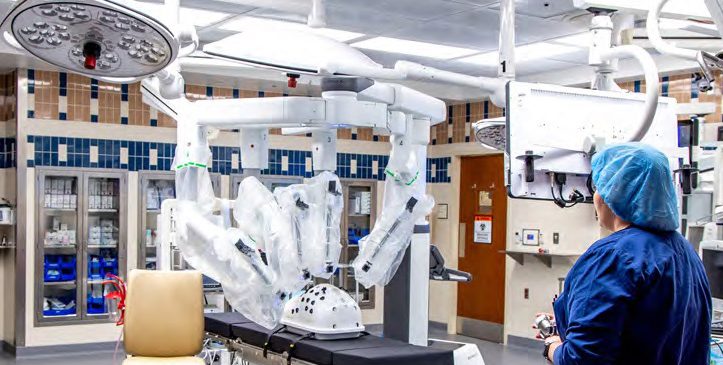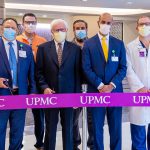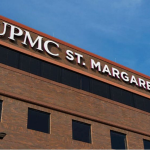Beginning in September, a helping hand will guide Dr. Sean Whelan and change the way he does certain surgeries at UPMC St. Margaret.
That change will come in the form of a da Vinci® Surgical Systems robot that arrived at the hospital in June. Whelan previously worked on robotic cases at UPMC Passavant with Dr. Kevin Garrett, and since joining UPMC St. Margaret in 2016, he has lobbied for a surgical robot at the hospital.
“I’m excited this technology is coming to UPMC St. Margaret,” Whelan said. “It will enable us to provide another surgical option that will benefit our patients.”
As a general surgeon, he will utilize the robot for procedures like gallbladder and hernia surgeries. Several other UPMC St. Margaret general surgeons also operate the robot. Dr. Robert Turner, a urologist with robotic experience, is expected to be the first surgeon to start using the new technology.
UPMC Jameson also recently acquired a surgical robot, and surgeons there will start using it this fall for urology and general surgery.
Get to Know da Vinci
Known as robot-assisted surgery, the type of minimally invasive procedure making its debut at UPMC St. Margaret and UPMC Jameson involves the use of tiny surgical instruments and a high-definition 3D camera. Rather than make a large incision to perform surgery, doctors make small cuts to insert the camera and tools. With robotic surgery, the surgeon can make more precise movements, while maintaining complete control over every movement for the duration of the surgery.
The da Vinci is used most often in complex or intricate procedures including cardiac, colorectal, general, gynecology, head and neck, thoracic, and urologic surgeries. Although robotic surgery can’t be used in every case, it can be helpful to both patients and physicians. Because it is less invasive, surgeons have a greater range of motion without the need to make large incisions. This can lead to fewer complications, a faster recovery, and less time spent in the hospital for patients.
Since 2000, when the first da Vinci Surgical Systems robot was approved by the Food and Drug Administration, it has been used in hundreds of thousands of surgeries across the United States.
“As medicine has progressed, this is just an additional and improved way to do surgery,” said Dawn Vocke, clinical director of the operating room at UPMC St. Margaret.
The use of robots continues to grow, as more than 12,000 advanced robotic surgical procedures have been performed at UPMC in the past five years. In 2011, 1,358 robotic surgeries were performed and by 2017 that number rose to 2,951.
“In this day and age, people want robotic surgery,” Whelan said. “The goal here is to offer a full spectrum of general surgical cases and provide all the options to our patients for inpatient and outpatient surgery.”
An Experienced Surgeon at the Console
 Dr. Jawaid Kalim, general and bariatric surgeon, has been performing robotic surgeries for nine years, six of which have been at UPMC Hamot. He uses the robot for some general surgeries, as well as bariatric procedures. UPMC Hamot has two da Vinci robots. Hamot’s robotic surgery program has continued to grow over the past decade, and it handles the most cases of any in the UPMC system. Kalim said there are now six UPMC Hamot physicians using the robot.
Dr. Jawaid Kalim, general and bariatric surgeon, has been performing robotic surgeries for nine years, six of which have been at UPMC Hamot. He uses the robot for some general surgeries, as well as bariatric procedures. UPMC Hamot has two da Vinci robots. Hamot’s robotic surgery program has continued to grow over the past decade, and it handles the most cases of any in the UPMC system. Kalim said there are now six UPMC Hamot physicians using the robot.
After scrubbing in for surgery, Kalim makes an incision into the patient and then attaches the robotic devices. After scrubbing out, he moves to the console, which is 10 to 20 feet away from the patient, to perform the surgery. He uses a small microphone on the console to communicate with operating room staff.
Because surgeons control the robot from the console and it mimics the movement of their hands, the distance they sit from the patient does not matter. Kalim explains that the biggest challenge when he began using a robot for surgery was the lack of physical interaction with the tools and the patient, as well as getting used to maneuvering the robot’s arms to make sure the proper tension was being used.
“You don’t get that haptic, physical touch, feedback,” Kalim said. “Touch is changed to visual feedback, and once you get used to it, it’s not a problem.”
Like UPMC St. Margaret, UPMC Passavant acquired a new robot at the beginning of the year, and the new addition (the hospital’s second da Vinci) has dramatically increased the hospital’s thoracic surgery program. Jaclyn Tresky, a clinician in the operating room, coordinates the use of the hospital’s robots. Surgeons at UPMC Passavant have been preforming robotic surgery for about seven years, and with the addition of the second machine, the hospital is positioned as a systemwide leader, second only to UPMC Hamot in terms of robotic surgery volumes.
When the new robot was brought to UPMC Passavant, the goal was to do more thoracic and colorectal procedures while continuing with general surgery. Jaclyn said the new robot is much more conducive to thoracic cases, which allows them to use it more often. Robotic surgery in that specialty, performed by Dr. Nicholas Baker, has thrived since its arrival.
In 2018, there were only 11 robotic thoracic cases performed at UPMC Passavant; through May of 2019, there were already 22. Because the surgeries are intricate procedures performed by highly trained physicians, the margin for error is small. Bringing the new robot into the operating room gives the team even more confidence in their ability to provide the best possible patient outcomes.
“Staff enjoy being in the room with the new robot, and the intensity of the cases has been reduced,” Tresky said. “The new robot has given everyone a greater sense of comfort, and Dr. Baker has created a great team approach, which is crucial in the operating room.”
Because the new robot has a wide range of movement, it allows surgeons to work in several parts of the body, which provides them with the flexibility to target specific areas, which Tresky said is “huge.”
Robust Training for Robotic Surgery
Whelan said UPMC has a great robotic training program, and he was trained using robots during his residency program.
Rebecca Rist, a robotic research associate and robotic curriculum coordinator, said Dr. Amer Zureikat, chief of the Division of Gastrointestinal Surgical Oncology at the UPMC Hillman Cancer Center, co-director of the UPMC Hillman Cancer Center Pancreatic Cancer Program, and associate professor of surgery at the University of Pittsburgh School of Medicine, has led the way for UPMC in robotic surgery training. He is beginning a robotic surgery credentialing program that will start at UPMC St. Margaret and expand to the other UPMC hospitals.
Rist said most UPMC general surgery residents have or are currently going through a robotic training program, and surgical oncology fellows are required to go through the robotic training.
Zureikat also is well known for conducting complex robotic procedures, and he administers a generalized robotic training program that attracts physicians from across the country and the world.
Like Whelan, more and more surgeons want to have robotic surgery as an option. And that trend is helping create better patient outcomes, a goal of every physician.
“I have had patients at the supermarket come up and give me a hug,” Kalim said. “They say, ‘You changed my life.’”
UPMC St. Margaret and UPMC Jameson will begin robotic surgery programs by September.
These 11 UPMC hospitals currently have active robotic surgery programs: UPMC Altoona, UPMC Chautauqua, UPMC Children’s Hospital of Pittsburgh, UPMC Hamot, UPMC Magee-Womens Hospital, UPMC Mercy, UPMC Pinnacle, UPMC Passavant, UPMC Presbyterian, UPMC Shadyside, and UPMC Susquehanna.








